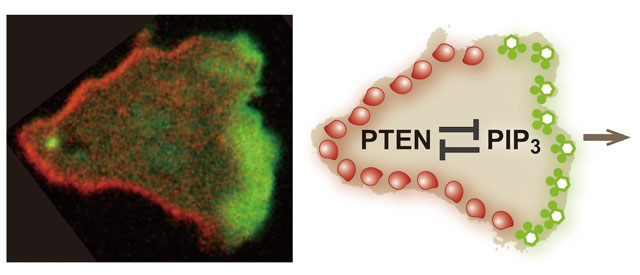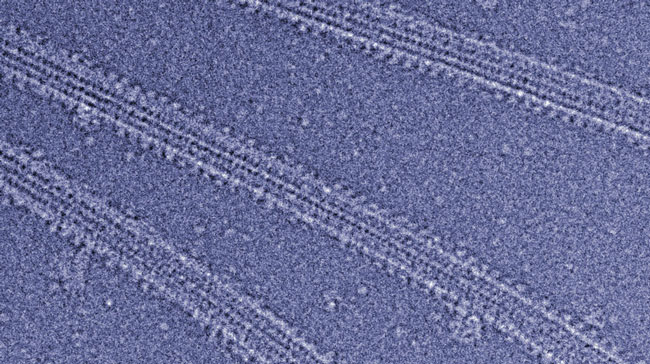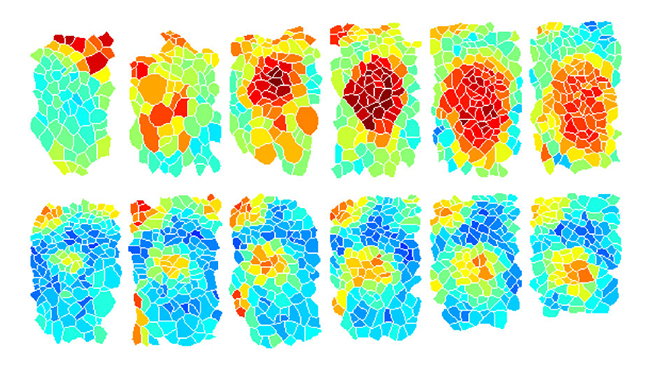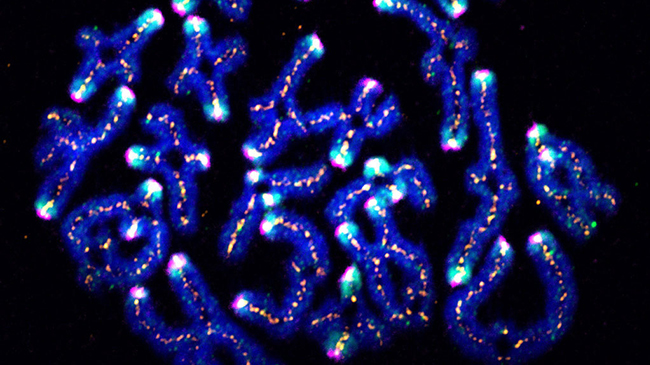BDR Research Highlights
The top image shows how tactile sensation is generated by the skin. Hair follicle stem cells (blue), which are important for hair shaft generation, secrete extracellular matrix proteins (green) that guide the connections of the neural network (red) to the skin, helping the skin to sense mechanical stimulation.
Image: Lab for Tissue Microenvironment
Scientists lay foundation for single-cell level understanding of DNA replication
Press release on February 26, 2019
Lab for Developmental Epigenetics developed a new method to examine DNA replication in individual cells, which revealed stability of DNA replication program and higher-order chromatin structure in mammalian cells.
Takahashi S, Miura H, Shibata T, et al. Nat. Genet. 51(3). 529-540 (2019)
Two inhibitory molecules ensure that cells move full steam ahead
RIKEN Research on January 11, 2019
Lab for Cell Signaling Dynamics reveal cells move in a single direction due to two mutually inhibiting molecules on their surfaces.
Matsuoka S, Ueda M. Nat Commun 9(1). 4481 (2018)

Microtubule and kinesin interactions send cellular cargo to the right destination
RIKEN Research on December 21, 2018
The molecular mechanism that ensures cellular cargo is transported along the right track has been identified by Lab for Cell Polarity Regulation.
Shima T, Morikawa M, Kaneshiro J, et al. J. Cell Biol. 217(12). 4164-4183 (2018)

Evolution of the inner ear: insights from jawless fish
Press release on December 6, 2018
Lab for Evolutionary Morphology has described for the first time the development of the hagfish inner ear. The study provides a new story for inner ear evolution that began with the last common ancestor of modern vertebrates.
Higuchi S, Sugahara F, Pascual-Anaya J, et al. Nature 565(7739). 347-350 (2019)
Creating a functional salivary gland organoid
Press release on October 11, 2018
Lab for Organ Regeneration succeeded in growing three-dimensional salivary gland tissue that, when implanted into mice, produced saliva-like normal glands.
Tanaka J, Ogawa M, Hojo H, et al. Nat Commun 9(1). 4216 (2018)
Gene Fam60a found to play a key role in the developing embryo
RIKEN Research on October 12, 2018
Lab for Organismal Patterning revealed that healthy development of an embryo depends on a protein that regulates the DNA of stem cells
Nabeshima R, Nishimura O, Maeda T, et al. Elife 7. e36435 (2018)
Getting a grip on the slow but unique evolution of sharks
Press release on October 9, 2018
By decoding the whole genomes of three shark species and comparing them with those of other vertebrate species, Lab for Phyloinformatics solved molecular riddles of their unique life histories and evolutionary paths.
Hara Y, Yamaguchi K, Onimaru K, et al. Nat Ecol Evol 2(11). 1761-1771 (2018)

Signaling relays offer an efficient alternative for coordinating embryonic development
RIKEN Research on September 21, 2018
Live imaging analysis of developing fly embryos by Lab for Morphogenetic Signaling reveal that a surprising ‘switch’-based signaling mechanism governs tissue formation.
Ogura Y, Wen FL, Sami MM, et al. Dev. Cell 46(2). 162-172.e5 (2018)

Two essential genes that regulate how much REM sleep we experience
Press release on August 29, 2018
Rapid eye movement (REM) sleep is a mysterious stage of sleep in which animals dream. Lab for Synthetic Biology has identified a pair of genes that regulate how much REM sleep an animal experiences.
Niwa Y, Kanda GN, Yamada RG, et al. Cell Rep 24(9). 2231-2247.e7 (2018)
Mechanism stabilizing chromosome pairs during meiosis identified
RIKEN Research on July 20, 2018
Lab for Chromosome Segregation show that modification with a protein called SUMO helps maintain proper chromosomal organization in newly produced egg cells.
Ding Y, Kaido M, Llano E, et al. Curr. Biol. 28(10). 1661-1669.e4 (2018)

New single-cell RNA sequencing methods could lead to better regenerative therapies
RIKEN Research on May 11, 2018
Lab for Bioinformatics Research developed an improved method for analyzing expression of genes by single cells with the potential to enhance regenerative medicine therapy as well as disease research.
Sasagawa Y, Danno H, Takada H, et al. Genome Biol. 19(1). 29 (2018)
